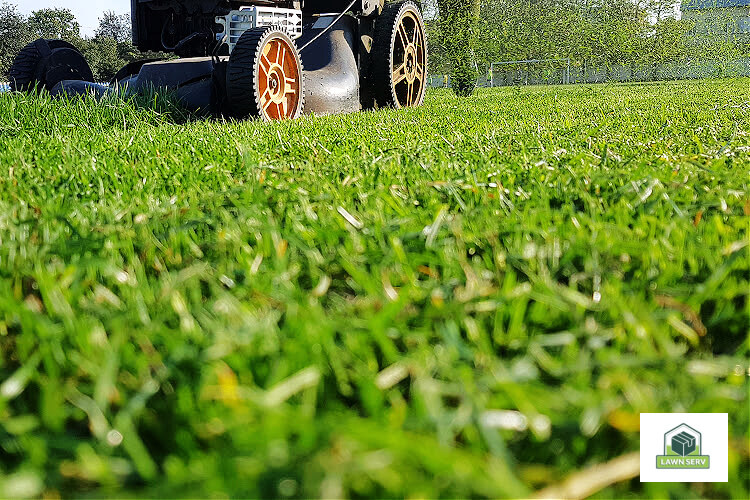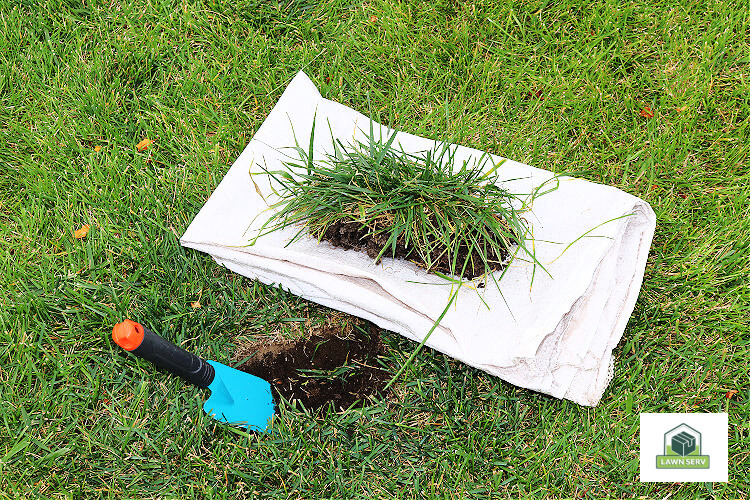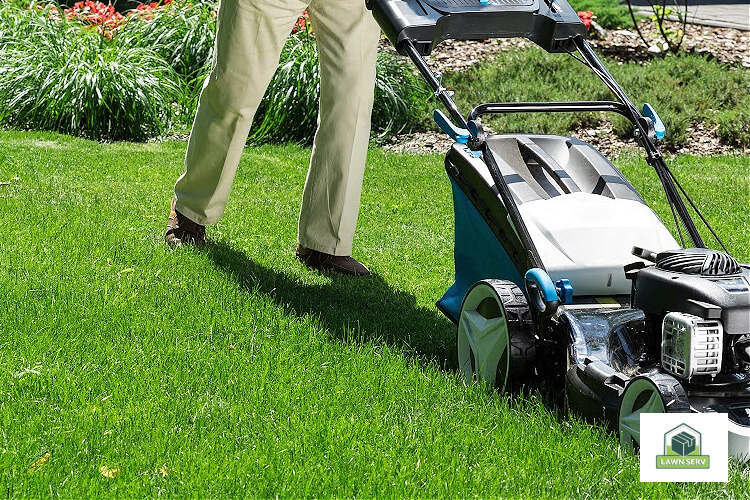
Ever stood in the heart of your yard, gazing at a sea of green and wondered, how to mow your lawn just right? It's an art that goes beyond crisscross patterns and summer sweat.
I remember my first encounter with a roaring mower. A battlefield ensued between man and nature - each blade of grass was an opponent needing careful attention. Little did I know then about the intricacies involved.
The magic lies not only in mastering how high or low you should trim but also knowing when it's time for those mower blades to take a break. Each swoop leaves behind more than mere lawn clippings; it’s an act shaping the destiny of every single grass plant underfoot.
Let's travel this path together, absorbing game-changing tips that could flip your usual lawn care on its head. Imagine taking simple steps and watching as they cultivate a lush, healthy lawn.
Table Of Contents:
- Understanding the Basics of Lawn Mowing
- Choosing the Right Lawn Mower and Blades
- Proper Lawn Mowing Techniques
- Maintaining Your Lawn Mower
- Lawn Care Tips for a Healthy Lawn
- Common Mistakes to Avoid
- Tips for Troubleshooting Lawn Issues
- FAQs in Relation to How to Mow Your Lawn
- Conclusion
Understanding the Basics of Lawn Mowing
To keep your lawn looking its best, you need to know some essential mowing tips. Let's begin with understanding how to set the proper height for your grass. The kind of grass in your yard will determine the right height for it. For instance, Kentucky bluegrass thrives when cut at 3-4 inches while warm-season grasses prefer a shorter cut.
Your lawn mower blade also plays an important role here. A dull blade can leave brown patches and cause damage that takes weeks to fix.
The frequency of mowing is another crucial aspect of lawn care service often overlooked by many homeowners but it helps maintain a thicker lawn with better roots. Regularly mowing is always a good idea for keeping your turf healthy, though the frequency can depend on things like weather and season.
Maintaining The Right Mowing Pattern
You should avoid mowing in the same direction each time as this could lead to soil compaction and hinder grass growth over time. Regularly changing up your pattern makes sure all parts get equal exposure and keeps everything balanced out nicely.
Avoiding Common Mistakes While Mowing
Cutting too much off at once or 'scalping' can be harmful - it exposes root systems leading them vulnerable to disease invasion. Remember never remove more than one-third rule from top part per session so that grassroots continue growing strong & robust. You might think you're saving yourself work by cutting short today – only having come back soon because scalped lawns grow faster necessitating frequent cuts.
Choosing the Right Lawn Mower and Blades

Selecting a suitable lawn mower depends on your lawn's size. A push mower might work for smaller yards, but large lawns may need riding mowers.
A dull blade can harm grass plants, leaving them vulnerable to diseases. Here's how you choose the right one. Key fact: sharpen your blades at least twice yearly. This keeps those blades sharp, reducing damage to grass blades and making sure that each cut is clean.
Grass type also influences which mower suits best. Cool-season grasses like Kentucky bluegrass prefer different cutting heights compared to warm-season types. Understanding these nuances helps keep your turf healthy.
You see, using an inappropriate or dull blade can be akin to shaving with a blunt razor - messy and painful.
Maintaining Your Blade Sharpness
To retain moisture in the yard during summer heatwaves (we all know they happen.), it's crucial not just to have a sharp blade but also regularly maintain it.
Dull blades tear through the grass instead of slicing cleanly; imagine tearing wrapping paper rather than cutting it – not pretty. These tears leave brown patches on lawns because torn edges lose more water than neatly cut ones do - another reason why keeping those mower blades sharp is essential.
.
The One-Third Rule: An Essential Tip
We're often tempted to give our lawns a good shearing now and then, aren't we? But here’s something surprising: never remove more than one-third of the height of your turf in any single mowing session as per this important rule followed by professional care service experts worldwide – I bet you didn’t know that.
Proper Lawn Mowing Techniques
The key to a healthy lawn is proper mowing. One vital tip is making sure you're cutting grass cleanly, not scalping it. Scalped grass weakens the root system and exposes your lawn to diseases and pests.
Maintaining sharp mower blades helps achieve this clean cut. Dull blades tear the grass instead of slicing it smoothly, leaving brown patches in your yard due to damaged tissue. It's like using a dull knife on a tomato - messy and inefficient. A sharp blade, however, will glide through with ease, giving your lawn that fresh haircut look.
Besides creating an appealing visual effect, changing up your mowing direction each time can also benefit turf health by preventing continuous bending in one path – imagine if you combed your hair only towards right every day; eventually it'd simply bend that way.
Finally, don't rush to bag those clippings post-mow. Leaving them behind might seem counterintuitive but these tiny bits are actually beneficial for the soil beneath as they decompose rapidly and return essential nutrients back into the ground (just make sure they’re under 1 inch long.). The result? You get greener pastures without spending extra on fertilizers.
Maintaining Your Lawn Mower
To get the best lawn possible, your lawn mower should be kept in top condition. But, just like any other machine, it needs some love and care too. Keeping your mower blades sharp not only ensures a clean cut but also prevents damage to the grass.
It's recommended by turfgrass specialists that you sharpen your mower blade at least twice a year. Trust me, it's worth the extra effort. A dull blade can make mowing more difficult and leave brown patches on your beloved green carpet.
The spark plug and air filter also play crucial roles in maintaining peak performance of your lawn mower. Over time these parts collect dirt which could affect how efficiently they function. Regularly cleaning or replacing them will let you avoid unnecessary breakdowns mid-mow.
If we're talking numbers here (and who doesn't love good stats?), then keep this one in mind: Sharp blades mean 30% less fuel consumption for gas-powered mowers.
To sum up - think of maintenance as feeding spinach to Popeye. The stronger he gets, the better he fights; likewise, taking care of small aspects such as sharpening the blade, checking the spark plug, and maintaining a clean air filter would go miles towards ensuring that every time you take out your lawnmower for its regular spin around the yard, it performs with gusto.
Lawn Care Tips for a Healthy Lawn

Maintaining a lush, green lawn is more than just regular mowing. It's about understanding the growing season of different grass species and implementing weed control strategies.
Mulching Grass Clippings
Did you know that mulching your grass clippings can serve as an organic fertilizer? These clippings return nitrogen to the soil, aiding in plant growth. Plus, they help retain moisture in the soil - quite handy during dry seasons.
The optimal time to cut the grass is either during mid-morning or after 4 in the afternoon, when temperatures are more bearable and less taxing on your turfgrass plants. And remember: never remove more than one-third of the grass blade height at once. This 'one-third rule' promotes healthier lawns by reducing stress on grass plants.
Your choice of mower also plays a part here. Different types of lawns need different kinds of care service; Kentucky bluegrass thrives under certain conditions while warm-season grasses like Bermuda have their own needs.
Cool-season grasses such as ryegrass and fescue typically require higher mowing heights than warm-season varieties like zoysia or St Augustine. So be sure to adjust your mower accordingly before hitting that start button.
Regular Mowing & Blade Maintenance
A well-sharpened mower blade ensures clean cuts instead of tearing through blades, which could lead to brown patches later on due to disease invasion into damaged tissue areas.
Keep in mind: For optimal performance, it's a good idea to sharpen your mower blades twice a year.
Common Mistakes to Avoid
We all goof up occasionally, but when it comes to tending your lawn, some mistakes can have long-term consequences. One such error is mowing the grass too short. It might seem like a time-saver now, but this practice can harm or even kill your precious turfgrass.
Cutting the grass extremely low—what's often called 'scalping'—can expose the soil and allow weeds to take root. Not only does scalping stress out your lawn, causing it to work harder to recover its health and vigor, but it also violates the one-third rule. The one-third rule states that it's best to not trim more than a third of the grass blade in any single mowing session.
Another common misstep? Mowing wet grass. Though sometimes unavoidable due to weather conditions or scheduling constraints, wet clippings are messy and hard on your mower blades. Plus they're likely to clump together, leaving unsightly brown patches where they block sunlight from reaching other plants underneath.
Besides making for a less-than-neat appearance, these clusters pose another problem: slipping hazards. Wet cuttings easily stick onto shoes—and everything else—which increases the risk of falls during or after mowing sessions.
Avoiding These Missteps Is Easier Than You Think.
Keeping in mind not just what you need to do—but also what you shouldn't—is key in maintaining an enviable yard year-round without having unnecessary hiccups along the way.
Tips for Troubleshooting Lawn Issues

Got brown spots on your lawn? Don't panic. Brown patches could simply be due to over-mowing or using a dull blade. To avoid this, try varying your mowing pattern as it can help prevent grooves in your yard and keep the grass vibrant.
Mower blades need sharpening regularly; a blunt blade rips through the grass rather than slicing it cleanly, causing damage that can lead to brown patches. Here's how you adjust the height of the mower.
Remember, each type of grass has its own optimal cutting height. For instance, Kentucky bluegrass thrives when cut between 2-3 inches high while warm-season grasses like Bermuda prefer shorter heights around 1-1.5 inches.
If you're struggling with regular lawn maintenance despite following these tips or if problems persist even after adjusting mowing habits and checking equipment, consider getting professional help from a reputable lawn care service. They'll know exactly what to do.
FAQs in Relation to How to Mow Your Lawn
How do you properly cut grass?
To properly cut grass, use a sharp blade and stick to the one-third rule - never slice off more than a third of the grass height at once. Also, mix up your mowing pattern each time.
How do you mow for beginners?
If you're new to mowing, start by choosing an easy-to-handle push mower. Maintain blades' sharpness and follow proper cutting techniques like avoiding over-mowing or scalping your lawn.
Do you mow first or edge first?
Mow your lawn first then tackle edging afterwards. This sequence allows clippings from edging to be picked up during the final clean-up process.
How do you cut grass like a professional?
Cut like a pro by keeping mower blades razor-sharp, varying the direction of cuts with every session, sticking to ideal cutting heights based on grass type and weather conditions; remember not all turf should be trimmed short.
Conclusion
Mastering how to mow your lawn is more than just an afternoon chore. It's about knowing the nuances of each grass blade, realizing when they need a trim and how much.
The one-third rule isn't merely for show - it ensures healthy roots and a thicker lawn that wards off weeds like an unsung hero. Your mower blades aren't just tools; they're guardians protecting against diseases while crafting the perfect cut every time.
Mulching those clippings is no lazy workaround but nature's way of feeding nutrients back into the soil. Each mowing pattern etches out not only aesthetics but also better growth direction for our green friends.
Maintaining your mower? That’s all part of being a responsible owner ensuring peak performance round after round.


